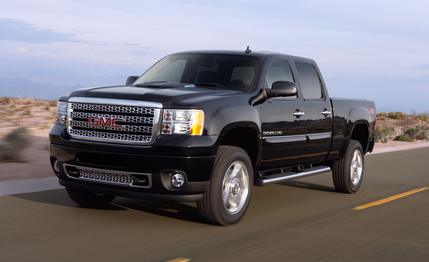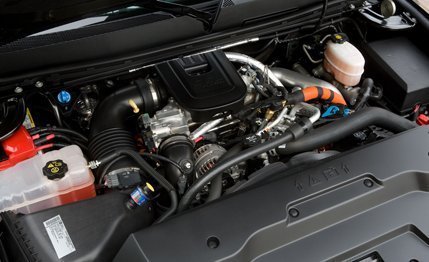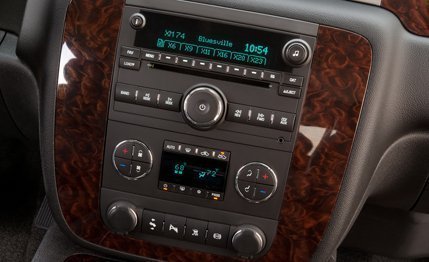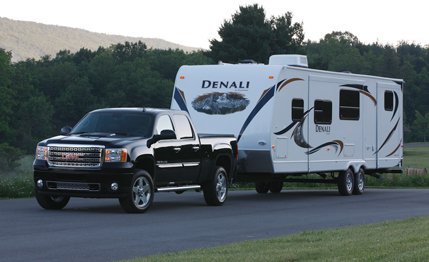
 Short Take Road Test
TESTED
Short Take Road Test
TESTED
Numbers are an obsession in the auto industry. Corporate suits worry about build costs, profit margins, and sales volumes; sports-car fans spend more time watching horsepower counts, acceleration times, and top speeds. But heavy-duty truck enthusiasts live and die by numbers, perhaps more than any other segment of the automotive sphere.
To that end, the 2011 GMC Sierra Heavy Duty—along with its Chevrolet Silverado twin—sees a couple of its key numbers swell to 6635 and 21,700. Those are the highest payload and trailer-weight capacities of the GM HD trucks; the totals for the 2500 truck tested here are 2631 and 16,800 pounds, respectively. But when we finished putting this GMC Sierra Denali 2500 through its paces, it wasn’t these digits that had our spreadsheets smoking.


Quick for a Big Guy
Indeed, a thoroughly overhauled Duramax turbo-diesel V-8 supplies the first pair of staggering numbers: 397 and 765. Those are the 6.6-liter engine’s respective hp and torque counts, the former peaking at 3000 rpm and the latter at 1600. Those two figures delivered the digits that simply blew us away—7.3 and 15.7, as in stopwatch ticks to 60 mph and through the quarter-mile, the latter feat occurring at 89 mph. What we have here is a 7560-pound truck that’s quicker than the first Chevy Camaro we ever tested and capable of hauling most of one in the bed or towing four behind it on a trailer.
Credit for this quickness is also due to the six-speed Allison automatic transmission, which keeps the Duramax spinning at the absolute peak of its prodigious power band while shifting with relative smoothness. (In contrast, the hard-shifting automatic in our long-term Ram 2500 changes gears as though it were trying to rip itself apart.) Most of the Sierra driving experience is similarly pleasant. The steering is nicely weighted and direct without being so nervous as to cause concerns about stability with a trailer aft. The brake pedal, too, feels surprisingly firm and communicative for one meant to be stomped on by work-booted feet and actuating a system responsible for halting 10 tons. Our haul down to 0 from 70 mph took 217 feet, which seems to be the standard for HD trucks, regardless of manufacturer: Of the five we’ve tested in recent months, all are clustered between 217 and 222 feet.
The Sierra is not without its flaws, however. Although a suspension designed to accommodate a one-ton payload atop the shoulders of a four-ton truck is never going to be compliant, there’s a difference between unyielding and uncivilized. Small impacts jostle occupants, but over larger impacts, the front axle feels detached, like it’s rattling in its bushings. “Unfinished” is hardly a confidence-inspiring vibe to get from a work truck.


Huge Truck, Disappointing Rear Legroom
Our other major complaint centers on the interior, where we encountered the Sierra’s first—and seemingly only—inadequate number. Despite the truck’s 240.1-inch overall length and 78.3-inch height, the back seat of the cab is snug in one key dimension. With legroom not even 1.5 inches greater than that found in the back seat of a Chevy Malibu (39.0 versus 37.6), even shorter staffers found the Sierra’s rear perch lacking. Ford’s F-series Super Duty crew cab offers 3.1 more inches than the Sierra (42.1), and in Mega Cab trim, the HD Ram offers enough interior space for the Detroit Pistons’ starting lineup.
Additionally, although the Denali package spruces up the interior, it doesn’t do anything about the low quality of the plastics. (At $1305 more than a similar Sierra SLT, the main benefit of the Denali package is the monochromatic exterior appearance.) The black tuxedo treatment inside and out masks the cheapness somewhat, but the massive expanse of black plastic that forms the inner door looks low-budget, as does the lower dash panel. Not only that, but the materials feel hard and hollow.
This interior might be passable in a base Sierra 1500 for $21,845, but in a truck that stickers at nearly three times that amount—our Sierra 2500 Denali came in at $61,244—it’s a glaring fault. Although the base price for a gasoline Denali HD is $46,860, the diesel option jolts the sticker north by $7195. The Allison transmission (broken out separately on the order form but mandatory with the diesel) is another $1200, bringing the base price of the diesel to $55,255. Our test example arrived with a navigation system ($2250), a sunroof ($895), 20-inch polished aluminum wheels ($850), chrome running boards ($689), heated and cooled front seats ($650), a rearview camera ($450), a heated steering wheel ($150), and a pair of engine covers for the grille and bumper opening that are required on diesel trucks sold in cold-weather states ($55).


Pull My Trailer
Although the total of $61,244 is an eye-opening number, that price is dead on with similarly outfitted and capable trucks from Ford and Dodge. (And remember that any less costly GM HD outfitted with this powertrain should prove equally well motivated.) From a numbers perspective, Ford still leads the HD truck segment with a max payload of 6520 pounds and a towing capacity of 24,400, as well as in diesel output, thanks to a recent upgrade to 400 hp and 800 lb-ft. However, despite the extra power, GM’s acceleration numbers embarrass a 2011 diesel F-250 we tested (8.0 seconds to 60 and 16.2 in the quarter at 86 mph). Most buyers aren’t drag-racing their 7600-plus-pound trucks—give yourself a high-five if you do and yours is in the 11s—but the Sierra’s fleetness means that, even with a gooseneck hanging off the back, it’ll be the Camry in the next lane that holds up traffic. Now if only GM could get serious about things not so easily quantified, such as ride quality and interior finish.